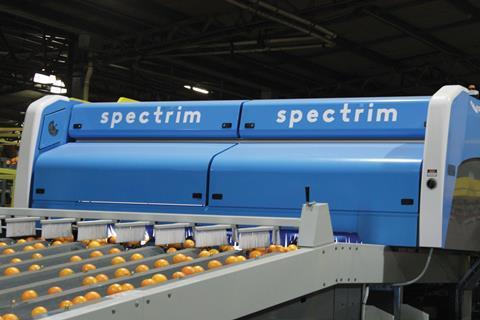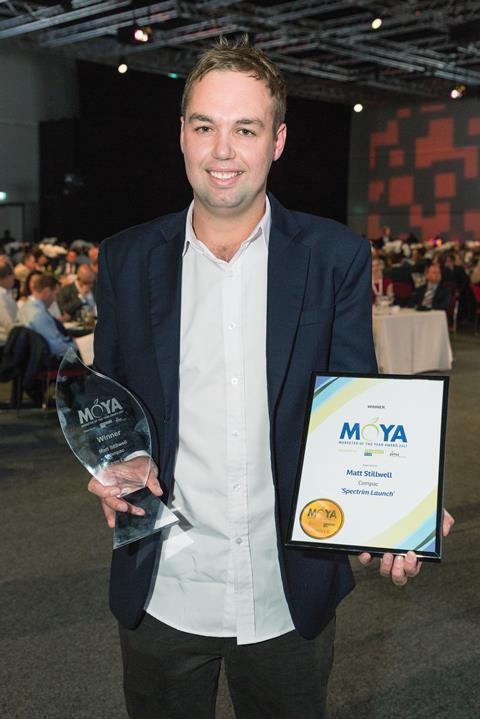The award-winning launch campaign for Compac’s new Spectrim solution proves that seeing really is believing.

The Hort Connections trade show provided the backdrop for the 2017 PMA Australia-New Zealand Produce Plus Marketer of the Year Award. Matt Stillwell, digital marketing manager of post-harvest equipment specialist Compac, scooped the coveted prize for his work on the launch of the Spectrim optical sorting platform. In an excusive interview with produce plus, Stillwell explains how a well orchestrated marketing campaign, delivered predominantly online, has driven sales and converted potential buyers into satisfied customers.
Firstly, congratulations. Can you tell us what winning the Marketer of the Year Award means to you?
Matt Stillwell: Winning the Marketer of the Year Award means a huge amount, especially at a time when marketing has such a big role to play in the fresh produce industry. We’ve recently seen Zespri take out a major New Zealand export award for their work in the US, while Hort Innovation has announced the Taste Australia initiative to help Australian producers grow their presence in export markets. It’s clear to see an importance is being placed on marketing in our sector.
Your winning campaign was built around Compac’s launch of the state-of-the-art Spectrim sorting platform in 2016. Can you tell us about the target audience for the campaign and how you structured your activity to highlight Spectrim’s key selling points?
MS: We had high confidence in the product internally, as we had a lot of smart people working behind the scenes. However, the product was yet to be validated at market level.
The ‘See it to believe it’ campaign was structured to create awareness for the product, and the goal was to get potential buyers to see the platform in action, either by touring a Spectrim-equipped packhouse, or a tradeshow demonstration.
The campaign focused on key areas where Spectrim was creating the most value for the packhouse. We wanted to highlight Spectrim’s consistency, the quality of pack, throughput and pack-out, along with its ability to reduce labour costs. We then created content around these points in the form of blogs, press releases and customer case studies.
One of the more intriguing elements of the campaign was that it segmented potential customers by identifying key personas at different stages of the Spectrim buyer’s journey. Can you explain the rationale behind this move and the response it received?
MS: For marketing to be successful it must be relevant, timely and specific. This is why buyer personas are so important. We have developed six buyer personas that represent key people within the packhouse. The personas help us to understand who we are communicating with and allow us to identify our audience’s pain points, goals and why they would be specifically interested in our technology. By understanding who we are talking to, we know exactly what to talk about.
For example, ‘Corporate Ken’ is a member of the C-suite team; he or she is interested in return on investment and is looking to ensure a quality, safe-eating experience for consumers. Then you have ‘Packhouse Pete’, who is the packhouse manager; he is more technical and interested in metrics like increasing throughput and reducing cost-per-pack, while ensuring reliability and ease-of-use.
The Spectrim campaign was designed to capture the attention of our personas at different stages of the buyer’s journey (awareness, consideration, decision) and move them to the next stage. The awareness stage was about creating content for our persona’s pain points or goals that were relevant to their roles within the fresh produce supply chain and matching it to a solution. The awareness content was mostly delivered in the form of blog articles, monthly newsletters and press releases.
Having personas also helps Compac stay a customer-centric company, as everyone understands what we are doing and why. The better we understand our buyer personas, the better each customer’s experience will be.
How did the idea for the campaign come up?
MS: Internally we knew that Spectrim was a giant leap on anything in the market, but we needed the market to feel the same way. We realised that our audience wanted to see Spectrim in action before believing us. Those who did see it were very impressed. That’s where the idea of ‘See it to believe it’ came from.
We had a behind-the-scenes video that showed the audience the value that Spectrim-equipped packhouses were receiving, complemented with the challenges and outcomes from the experts who developed the product. After watching the video, we followed-up with an invite to see Spectrim in action, either at a packhouse or at a tradeshow.
All the work for this campaign was done in-house, with the exception of the video, which we developed with an agency. A lot of work was done by our product management team, who worked closely with our R&D team and launch customers to truly understand Spectrim’s business value. We also invested in a marketing automation tool, which enabled us to deliver the campaign and monitor results.

Another interesting aspect of the campaign was that it was predominately delivered online. What advantages and/or pitfalls did this present with regard to cost and penetration?
MS: I guess online is how most people consume content, so it made sense to focus on our online channels. Rather than sending product experts to every market to educate one person at a time, the campaign allowed us to educate more people at a lower cost. It also allowed our audience to engage with the different pieces of content in their own time, at their own pace. If and when they had any questions, they could reach out. The campaign was also optimised for mobile use, to cater for the 24 per cent of our audience that consume our content via mobile devices.
The biggest advantage we got from having the campaign online related to the reporting and analytics we could do. This really helped measure the return on investment of the campaign and it also helped us create better content, as we could see what was performing well and what wasn’t.
In terms of pitfalls, there is the chance that you might miss some people who aren’t that active online, but that is where trade shows and printed trade media fitted nicely into the campaign.
As you mentioned, online analytics provided Compac with a means of measuring the success of the campaign. Can you share with us any tangible evidence or figures that highlight how well it performed?
MS: We are still looking at how many people enter the sales funnel and how many are converting. We use this data to create more content that is specific to our audience. Over the last year we have increased our website traffic by 155 per cent, created over 780 leads and achieved NZ$50m in Spectrim sales.
With the launch phase now seemingly complete, where next for Spectrim platform marketing?
MS: The launch is complete but the marketing campaign will keep going, and we will continue to work on new content as we expand the Spectrim offering into other commodities. On the back of the successful launch, we are now seeing more demand from non-English speaking countries, so I’m currently considering ways to make sure our content is relevant for all our markets.
With Spectrim being designed as a platform, we are releasing continual updates to hardware and software, to ensure our customers stay at the leading edge of technology. So as our R&D team continues to deliver new features, my team will continue to create content to build awareness.
